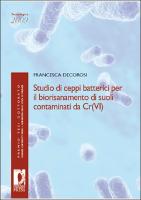Studio di ceppi batterici per il biorisanamento di suoli contaminati da Cr(VI)
| dc.contributor.author | Decorosi, Francesca | |
| dc.date.accessioned | 2022-05-31T10:16:18Z | |
| dc.date.available | 2022-05-31T10:16:18Z | |
| dc.date.issued | 2010 | |
| dc.identifier | ONIX_20220531_9788884539366_185 | |
| dc.identifier | OCN: 971075239 | |
| dc.identifier.issn | 2612-8020 | |
| dc.identifier.uri | https://library.oapen.org/handle/20.500.12657/54901 | |
| dc.language | Italian | |
| dc.relation.ispartofseries | Premio Tesi di Dottorato | |
| dc.title | Studio di ceppi batterici per il biorisanamento di suoli contaminati da Cr(VI) | |
| dc.type | book | |
| oapen.abstract.otherlanguage | Chromium, in its hexavalent form [Cr(VI)], is a dangerous environmental pollutant. Bioremediation, which exploits the capacity of microorganisms to reduce Cr(VI) to Cr(III), is an interesting alternative to chemical-physical technologies for the rehabilitation of soil contaminated by Cr(VI). This study has made it possible to obtain a profound phenotypical characterisation of a number of bacterial strains capable of reducing and resisting Cr(VI), making it possible to identify various candidates that could potentially be employed in bioremediation. Moreover, a new gene involved in resistance to Cr(VI) has also been identified, the primary function of which consists in the induction of the cellular response to sulphur starvation. The study of this gene has highlighted that the sulphur content of the soils is one of the parameters that can influence the bioremediation of soils contaminated with Cr(VI). | |
| oapen.identifier.doi | 10.36253/978-88-8453-936-6 | |
| oapen.relation.isPublishedBy | bf65d21a-78e5-4ba2-983a-dbfa90962870 | |
| oapen.relation.isbn | 9788884539366 | |
| oapen.relation.isbn | 9788884539854 | |
| oapen.relation.isbn | 9788892736924 | |
| oapen.series.number | 16 | |
| oapen.pages | 140 | |
| oapen.place.publication | Firenze |

